|

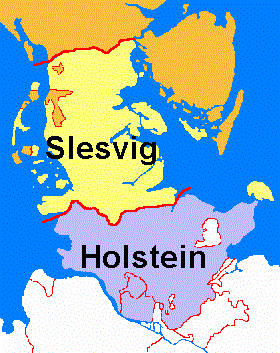
The conflict over the two duchies Schleswig and Holstein is a central
part of Denmark’s history. It all started in 1232 when king Valdemar Sejr
granted his younger son Abel the hereditary duchy of Sønderjylland (later
called Schleswig). Abel and his heirs caused Denmark considerable problems
because of their disloyalty to the crown, and they made alliances with the
German counts of Holstein (house of Schauenburg) at an early stage. The
Schauenburgers took control over Schleswig 1375 when the last duke from
Abel’s line died. Queen Margrethe was forced to accept fait accompli and
grant Schleswig as a hereditary Danish duchy to Gerhard IV 1386.
Denmark tried several times without success during the 15th
Century to return Schleswig to the Danish crown. Despite the fact that his claims had support
from the German emperor the danish king Erik of Pomerania fought a
long indecisive war over Schleswig 1410-1435 . The conflict was only solved when duke Adolf
of Schleswig-Holstein died without sons 1459. This would have resulted in
the return of Schleswig to the Danish crown and that Holstein would have
been inherited by a different branch of the house
of Schauenburg. The nobility in Schleswig and
Holstein however elected the Danish king Christian I as duke and count after
he promised that Schleswig and Holstein would for all eternity be undivided
and united. This complicated arrangement with a permanent union between the
Danish duchy of Schleswig and the German county of Holstein (duchy from
1474) would create intricate legal problems concerning the succession in the
19th Century due to different laws in Denmark and Germany.
The arrangement got even more complicated 1490 when the duchies were divided between
king Hans and his brother Frederik. Hans and Frederik became co-regents over
Schleswig and Holstein so that the duchies would still be united and
administrated by one government. But they carved out the territories into
royal, ducal and jointly ruled portions.
 Unity was temporarily restored 1523 when duke Frederik deposed his nephew
Christian II and became king of Denmark. But Schleswig and Holstein were
divided again 1544 in a similar manner as in 1490. This time it was between
king Christian III and his two brothers Hans the elder and Adolf (founder of
the house of Holstein-Gottorp). 1564 Christian III granted a forth duchy to
his son Hans the younger. But unlike the previous division Hans the younger
did not get a part of the government over Schleswig and Holstein. Hans the elder died
without sons 1580 and his duchy was therefore divided between king Frederik
III and the dukes Adolf and Hans the Younger. After that the borders of
Schleswig-Holstein were as shown on the map below. Unity was temporarily restored 1523 when duke Frederik deposed his nephew
Christian II and became king of Denmark. But Schleswig and Holstein were
divided again 1544 in a similar manner as in 1490. This time it was between
king Christian III and his two brothers Hans the elder and Adolf (founder of
the house of Holstein-Gottorp). 1564 Christian III granted a forth duchy to
his son Hans the younger. But unlike the previous division Hans the younger
did not get a part of the government over Schleswig and Holstein. Hans the elder died
without sons 1580 and his duchy was therefore divided between king Frederik
III and the dukes Adolf and Hans the Younger. After that the borders of
Schleswig-Holstein were as shown on the map below.
 = Domains of the Danish king
= Domains of the Danish king
 = Schleswig-Holstein-Gottorp
= Schleswig-Holstein-Gottorp
 = Jointly administrated territories
= Jointly administrated territories
 = Schleswig-Holstein-Sønderborg
= Schleswig-Holstein-Sønderborg
Schleswig-Holstein-Sønderborg was the duchy that was granted to Hans the younger 1564.
Because its dukes did not take part in the government of Schleswig and
Holstein is this duchy marked as a part of the king of Denmark’s domains in
the maps below. The last part of that duchy was returned to the crown 1863
when its duke became king of Denmark.
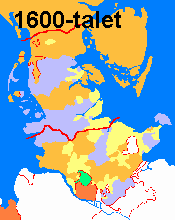 |
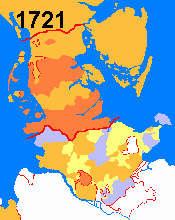 |
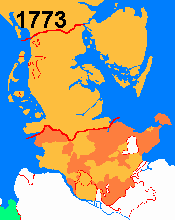 |
| The last member of the house of
Schauenburg dies 1640 and his part of Holstein goes to the king of Denmark.
The county of Rantzau is created 1650 after Christian Rantzau had purchased
it from Denmark. The county of Oldenburg is inherited by the Danish king
1667. |
As a result of the Great
Northern War the duke of Holstein-Gottorp lose all parts of Schleswig to the
Danish king. The county of Rantzau is also returned to Denmark this year. |
Oldenburg is exchanged for the
last parts of the duchy of Holstein-Gottorp. |
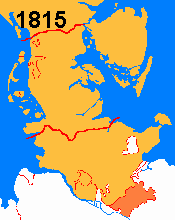 |
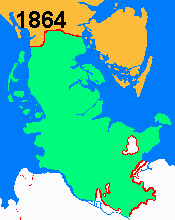 |
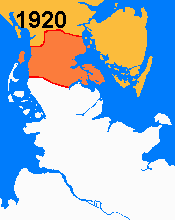 |
| The congress in Vienna decides
that Denmark must exchange Vorpommern for Lauenburg. |
Schleswig-Holstein is lost to
Prussia after the second war over Schleswig. |
Northern Schleswig is returned
to Denmark after a plebiscite. |
|

